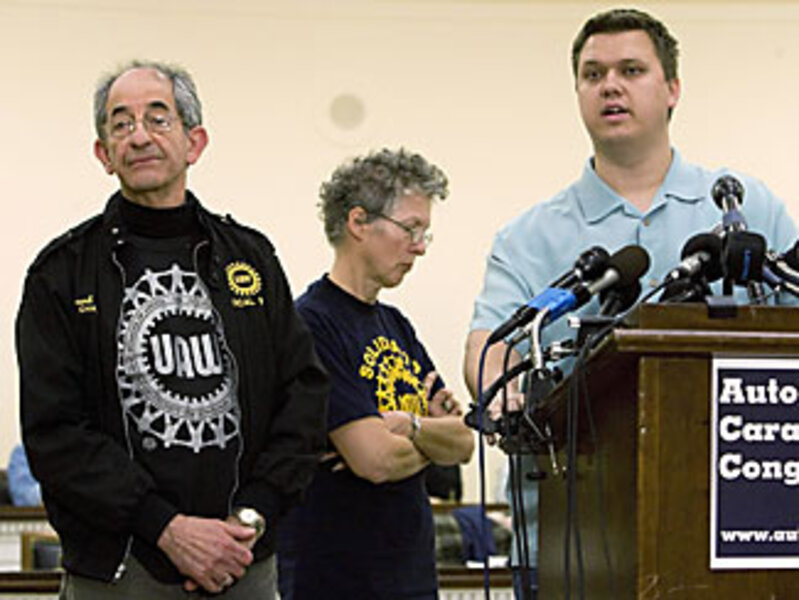A government-run auto industry?
Loading...
| Washington
The proposed $15 billion rescue plan that drew lawmakers back to Capitol Hill this week gives Washington a strong hand in shaping the future of the US auto industry.
In sharp contrast to the relatively lax terms of the recent $700 billion bailout for the financial services industry, the auto rescue plan sets up a level of government oversight and control not seen since World War II.
The draft plan Democratic leaders sent to the White House this week sets up a two-stage process loosely tied to the timetable of the outgoing and incoming presidential administrations.
It allows the Bush administration to launch the rescue effort, but leaves key decisions about the scale and scope of the overhaul to the incoming Obama administration.
While the plan allows cash to begin flowing to struggling auto companies as early as next week, a long-term restructuring, including any sacrifices to be made by various stakeholders, is put off until March 31.
At the heart of the overhaul is a controlling role for a presidential appointee, quickly dubbed "car czar." This position – which is not expected to require Senate confirmation – is tasked with authorizing bridge loans and setting benchmarks for measuring progress.
In exchange for bridge loans, the auto industry would give government an ownership stake, or warrants for company stock, and control over the terms of retrenchment.
In a bid to deflect criticism that automakers will keep coming back for new loans, Democratic leaders negotiating the plan with the White House say Congress will insist the industry demonstrate accountability and viability.
"Unless the restructuring that is called for in this legislation and the goal of viability is achieved by March 31, there is no justification for spending more taxpayer dollars," said House Speaker Nancy Pelosi in a briefing announcing the deal on Monday. Votes in the House and Senate are expected by the end of the week.
Debate over fuel conditions
But even before the final legislation takes shape, the debate over an auto rescue plan is already shifting the terms of longstanding environmental debates, especially over whether US auto manufacturers should be required to meet higher state fuel-economy standards.
"General Motors and Chrysler have said over and over in court that they can't make these standards work and stay in business," says Boston attorney Matthew Pawa, who represents environmental groups in lawsuits against auto companies.
Yet, in making their case for a bailout to Congress last week, both GM and Ford Motor Co. submitted plans that claim their companies will meet such standards.
"Now that Detroit is coming to Capitol Hill for money, there's a huge opening for Congress to require that they meet California's greenhouse-gas standards by enacting a one-sentence law that would effectively rule out these lawsuits," Mr. Pawa adds.
In one of the most controversial elements of the proposal, Democrats propose banning auto manufacturers accepting financial assistance under the new law from "participating in, pursuing, funding, or supporting in any way any legal challenge (existing or contemplated) to state laws concerning greenhouse gas emission standards."
At a hearing on the energy implications of the auto bailout on Tuesday, Rep. Ed Markey (D) of Massachusetts said he expected a battle over this provision, which the White House opposes. American taxpayers deserve higher fuel economy performance in return for their investment in the auto industry, he said.
"If they're testifying to the effect that they can meet that standard, doesn't it make sense to put their promises technologically into the law, so at least the Sierra Club ... can sue them if they don't meet that standard?" Mr. Markey said at Tuesday's hearing of the Select Committee on Energy Independence and Global Warming. Markey is chair of the committee.
On Monday, the National Resources Defense Council (NRDC) released a report that converted the miles per gallon (m.p.g.) values in the companies' business plans to greenhouse-gas (GHG) emission rates.
If those company projections are accurate, both Ford and GM would "easily meet the 2015 California GHG standards nationwide," the report concludes.
"GM's plan states that it will achieve 2012 fuel economy levels of 37.3 mpg and 27.5 mpg for their new car and light truck fleets, respectively. The projected GHG emission level would enable GM to comply with a national version of the California GHG standards in 2012."
"The issue now is to make sure these are not false promises in exchange for bailout money," says Roland Hwang, NRDC vehicle policy director.
Congressional leaders say they expect to take up a draft version of this bill as early as Wednesday.
"There are two remaining issues that have been discussed with the White House. I'm confident that those matters can be resolved within the next hour or so," said Senate majority leader Harry Reid in a floor statement Tuesday.
Unprecedented intervention
If the draft legislation becomes law, it marks a dramatic move of the federal government into industrial policymaking.
From railroads in the 19th century to huge investments in aerospace and computer technology in the 20th century, the US government has a history of investing in major industries as well as crisis intervention.
"This goes all the way back to the founding of the nation," says Nancy Koehn, a business historian at Harvard Business School.
What's distinctive about the proposed auto bailout is the degree of government involvement. "With the exception of World War II, I cannot recall another instance where government was going to step in and regulate issues such as executive compensation or the use of corporate jets," she adds.
"It's not quite nationalization of our auto industry, but it's getting there," says Joan Claybrook, president of Public Citizen.






